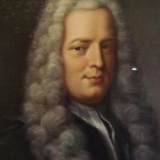
Gabriel Cramer
Encyclopedia
Gabriel Cramer was a Swiss mathematician
, born in Geneva
. He showed promise in mathematics
from an early age. At 18 he received his doctorate and at 20 he was co-chair of mathematics.
In 1728 he proposed a solution to the St. Petersburg Paradox
that came very close to the concept of expected utility theory
given ten years later by Daniel Bernoulli
.
He published his best known work in his forties. This was his treatise on algebraic curve
s, "Introduction à l'analyse des lignes courbes algébriques", published in 1750. It contains the earliest demonstration that a curve of the n-th degree is determined by
on it, in general position
. He edited the works of the two elder Bernoullis; and wrote on the physical cause of the spheroidal shape of the planet
s and the motion of their apsides (1730), and on Newton
's treatment of cubic curves (1746). He was professor at Geneva, and died at Bagnols-sur-Cèze
.
He was the son of physician Jean Cramer and Anne Mallet Cramer.
Mathematician
A mathematician is a person whose primary area of study is the field of mathematics. Mathematicians are concerned with quantity, structure, space, and change....
, born in Geneva
Geneva
Geneva In the national languages of Switzerland the city is known as Genf , Ginevra and Genevra is the second-most-populous city in Switzerland and is the most populous city of Romandie, the French-speaking part of Switzerland...
. He showed promise in mathematics
Mathematics
Mathematics is the study of quantity, space, structure, and change. Mathematicians seek out patterns and formulate new conjectures. Mathematicians resolve the truth or falsity of conjectures by mathematical proofs, which are arguments sufficient to convince other mathematicians of their validity...
from an early age. At 18 he received his doctorate and at 20 he was co-chair of mathematics.
In 1728 he proposed a solution to the St. Petersburg Paradox
St. Petersburg paradox
In economics, the St. Petersburg paradox is a paradox related to probability theory and decision theory. It is based on a particular lottery game that leads to a random variable with infinite expected value, i.e., infinite expected payoff, but would nevertheless be considered to be worth only a...
that came very close to the concept of expected utility theory
Expected utility hypothesis
In economics, game theory, and decision theory the expected utility hypothesis is a theory of utility in which "betting preferences" of people with regard to uncertain outcomes are represented by a function of the payouts , the probabilities of occurrence, risk aversion, and the different utility...
given ten years later by Daniel Bernoulli
Daniel Bernoulli
Daniel Bernoulli was a Dutch-Swiss mathematician and was one of the many prominent mathematicians in the Bernoulli family. He is particularly remembered for his applications of mathematics to mechanics, especially fluid mechanics, and for his pioneering work in probability and statistics...
.
He published his best known work in his forties. This was his treatise on algebraic curve
Algebraic curve
In algebraic geometry, an algebraic curve is an algebraic variety of dimension one. The theory of these curves in general was quite fully developed in the nineteenth century, after many particular examples had been considered, starting with circles and other conic sections.- Plane algebraic curves...
s, "Introduction à l'analyse des lignes courbes algébriques", published in 1750. It contains the earliest demonstration that a curve of the n-th degree is determined by
- n(n + 3)/2 points
on it, in general position
General position
In algebraic geometry, general position is a notion of genericity for a set of points, or other geometric objects. It means the general case situation, as opposed to some more special or coincidental cases that are possible...
. He edited the works of the two elder Bernoullis; and wrote on the physical cause of the spheroidal shape of the planet
Planet
A planet is a celestial body orbiting a star or stellar remnant that is massive enough to be rounded by its own gravity, is not massive enough to cause thermonuclear fusion, and has cleared its neighbouring region of planetesimals.The term planet is ancient, with ties to history, science,...
s and the motion of their apsides (1730), and on Newton
Isaac Newton
Sir Isaac Newton PRS was an English physicist, mathematician, astronomer, natural philosopher, alchemist, and theologian, who has been "considered by many to be the greatest and most influential scientist who ever lived."...
's treatment of cubic curves (1746). He was professor at Geneva, and died at Bagnols-sur-Cèze
Bagnols-sur-Cèze
Bagnols-sur-Cèze is a commune in the Gard department in the Languedoc-Roussillon région in southern France.-History:A small regional center, Bagnols-sur-Cèze was quite certainly a Roman town before the main part was built in the 13th century around a central arcaded square that is still preserved...
.
He was the son of physician Jean Cramer and Anne Mallet Cramer.
External links
- Cramer's Paradox at MathPages

